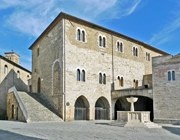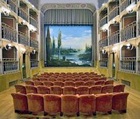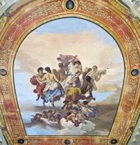
The earliest documentary evidence of a communal government in Bevagna dates to 1187, when four consuls (representing respectively the nobility, the merchants, the artisans and the citizens of the contado) were appointed for two-month periods to preside over a council of 60 representatives.
In 1249, Bevagna and Coccorone rebelled against the Emperor Frederick II and the hegemony of Foligno. The imperial general Tommaso d’ Aquino, Conte di Acerra retook both cities and sacked them.
The completion of the present palazzo marked the rebirth of the city. It is attributed to Maestro Prode, who built the exactly contemporary Palazzo Comunale at Spello. It was the seat of government of Bevagna until 1832, when it was badly damaged in an earthquake.
The ground floor is made up of an open loggia with two vaulted naves, and the main façade above has two orders of bifore windows. The entrance is via a large staircase on the side that leads to the great hall on the first floor. The arms of Bevagna and the terracotta arms of the Trinci family of Foligno, who ruled Bevagna in the period 1371-1439, are above an older entrance on this wall, which is now closed.
Teatro Francesco Torti (1872-86)

The original curtain was painted by Domenico Bruschi: its successor contains a painting (1994) by Luigi Frappi of the Clitunno at sunrise, in which Propertius points out his (allegedly) native Bevagna to Francesco Torti.
To visit the theatre, enquire at Palazzo Lepri in Corso Matteotti.







